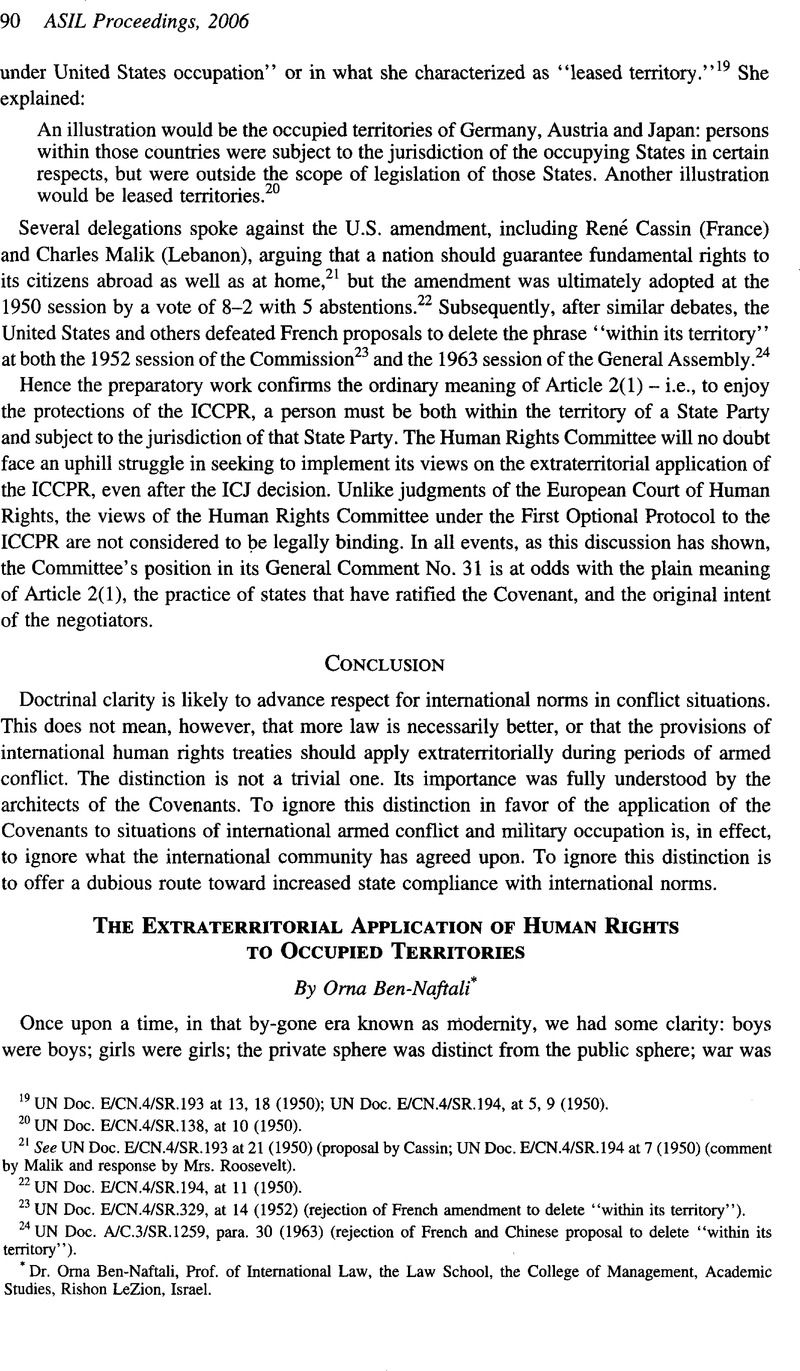Published online by Cambridge University Press: 28 February 2017

1 For the argument that the Israeli occupation has substituted the “indefinite” for the “temporary,” see Ben-Naftali, Orna, “A la Recherche du Temps Perdu”: Rethinking Article 6 of the Fourth Geneva Convention in the Light of the Legal Consequences of the Construction of a Wall in the Occupied Palestinian Territory Advisory Opinion, 38 Isr. L. Rev. 211 (2005)CrossRefGoogle Scholar.
2 This part of the presentation is based on Orna Ben-Naftali & Shany, Yuval, Living in Denial: The Application on Human Rights in the Occupied Territories, 37 Isr. L. Rev. 17 (2003-2004)Google Scholar.
3 Teitel, Ruti, Humanity’s Law: Rule of Law for the New Global Politics, 35 CornellInt’l L.J. 355 (2002)Google Scholar.
4 The point is best exemplified by Israel’s argument that neither the Fourth Geneva Convention nor IHR apply to the occupied Palestinian territory. On the former position, see, e.g., Blum, Yehuda Zvi, The Missing Reversioner: Reflections on the Status of Judea and Samaria, 3 Isr. L. Rev. 279 (1968)CrossRefGoogle Scholar. On the latter position, see, e.g., State of Israel International Covenant on Civil and Political Rights—Second Periodic Report, Nov. 20, 2001 para. 8, UN Doc. CCPR/CYISR/2001/2 (2001).
5 Carl Schmitt, Political Theology (1985); Giorgio Agamben, Homo Saccer: Sovereign Rower and Bare Life (1998); Giorgio Agamben, State of Exception (2005).
6 Even if the U.S. reading of the travaux préparatoires is the only possible reading, and it is not, the travaux indicate that the reference to “within its territory” was designed to clarify that states would not be obliged to interfere coercively abroad to comply with their obligations under the ICCPR. See UN Doc. E/CN.4/SR.194 (1950) paras. 15, 16, 31,32.
7 E.g., Comm. R.12/52 Lopez-Burgos v. Uruguay, UN Doc. A/36/40 (1981). (Note that Professor Tomuschat, who agreed with the majority that wilful and deliberate attacks by a state against its own nationals abroad are covered by the ICCPR, was in a minority when opting for a stricter interpretation of the scope of jurisdiction of the ICCPR.)
8 E.g., Report No. 109/99 Coard v. U.S., Sept. 29, 1999, available at <http://www.cidh.oas.org/annualrep/99eng/Merits/UnitedStatesl0.951.htm>.
9 Legality of the Use by a State of Nuclear Weapons in Armed Conflict, Advisory Opinion, 1996 ICJ Rep. 226 para. 25; Legal Consequences of the Construction of a Wall in the Occupied Palestinian Territory, Advisory Opinion (Int’l Ct. lustice July 9, 2004), 43 ILM 1009 (2004) paras. 104-06.
10 E.g., Prosecutor v. Furundzija, No. IT-95-17/1-T, para. 183 (Dec. 10, 1999), 121 ILR 214.
11 E.g., Loizidou v. Turkey, 1996-VI, Eur. Ct. H.R. 2216, paras. 62, 72-75.
12 Al Skeini v. Secretary of State for Defence, [2004] EWHC 2911, available at <http://www.bailii.org>. “Bankovic v. Belgium, Admissibility, App. No. 52207/99 (Eur. Ct. H.R. Dec. 12, 2001), 213 ILR (2003) 94.
14 Note that the degree—indeed, the existence—of effective control exercised by Israel over the Gaza Strip following the withdrawal (disengagement) is pending before the HCJ. The state maintains that it has none, and thus no obligations under IHL or IHR. The petitioners maintain that the control Israel exercises over Gaza’s air, water, and land borders; the transfer of goods and people; Gaza’s residents’ registry; custom, and thereby the ability of public institutions to receive foreign donations and salaries of civil servants through taxation indicate such control.
15 Ocalan v. Turkey, [2003] ECHR 125 (Mar. 12, 2003). It should be noted that the decision retreated from Bankovic regarding the ECHR zone of application.
16 Mar’abe v. The IDF Commander in Judea and Samaria, HCJ 3239/02.
17 The U.S. Operational Handbook 2004, ch. III, §11 (Berger, Grime, & Jensen eds.).
18 Lubell, Noam, Challenges in Applying Human Rights Law to Armed Conflicts, 87 Int’L Rev. Red Cross 737 (2005)CrossRefGoogle Scholar.
19 Mara’abe v. The Prime Minister of Israel, No. HCJ 7957/04, available at <http://elyonl.court.gov.il/files_eng/ 04/570/079/al4/04079570.al4.pdf>.
20 Gross, Aeyal, The Construction of a Wall Between the Hague and Jerusalem: The Enforcement and Limits of Humanitarian Law and the Structure of Occupation, 19 Leiden J. Int’l L. (forthcoming 2006)Google Scholar.